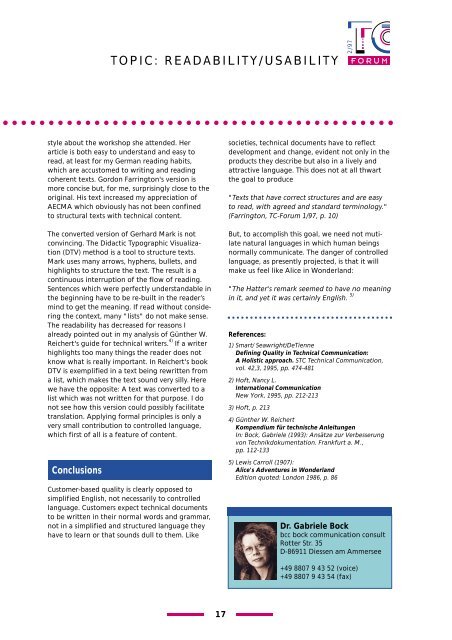TC Forum 97-2
TC Forum 97-2
TC Forum 97-2
Create successful ePaper yourself
Turn your PDF publications into a flip-book with our unique Google optimized e-Paper software.
style about the workshop she attended. Her<br />
article is both easy to understand and easy to<br />
read, at least for my German reading habits,<br />
which are accustomed to writing and reading<br />
coherent texts. Gordon Farrington's version is<br />
more concise but, for me, surprisingly close to the<br />
original. His text increased my appreciation of<br />
AECMA which obviously has not been confined<br />
to structural texts with technical content.<br />
The converted version of Gerhard Mark is not<br />
convincing. The Didactic Typographic Visualization<br />
(DTV) method is a tool to structure texts.<br />
Mark uses many arrows, hyphens, bullets, and<br />
highlights to structure the text. The result is a<br />
continuous interruption of the flow of reading.<br />
Sentences which were perfectly understandable in<br />
the beginning have to be re-built in the reader’s<br />
mind to get the meaning. If read without considering<br />
the context, many "lists" do not make sense.<br />
The readability has decreased for reasons I<br />
already pointed out in my analysis of Günther W.<br />
Reichert's guide for technical writers. 4) If a writer<br />
highlights too many things the reader does not<br />
know what is really important. In Reichert's book<br />
DTV is exemplified in a text being rewritten from<br />
a list, which makes the text sound very silly. Here<br />
we have the opposite: A text was converted to a<br />
list which was not written for that purpose. I do<br />
not see how this version could possibly facilitate<br />
translation. Applying formal principles is only a<br />
very small contribution to controlled language,<br />
which first of all is a feature of content.<br />
Conclusions<br />
TOPIC: READABILITY/USABILITY<br />
Customer-based quality is clearly opposed to<br />
simplified English, not necessarily to controlled<br />
language. Customers expect technical documents<br />
to be written in their normal words and grammar,<br />
not in a simplified and structured language they<br />
have to learn or that sounds dull to them. Like<br />
17<br />
societies, technical documents have to reflect<br />
development and change, evident not only in the<br />
products they describe but also in a lively and<br />
attractive language. This does not at all thwart<br />
the goal to produce<br />
"Texts that have correct structures and are easy<br />
to read, with agreed and standard terminology."<br />
(Farrington, <strong>TC</strong>-<strong>Forum</strong> 1/<strong>97</strong>, p. 10)<br />
But, to accomplish this goal, we need not mutilate<br />
natural languages in which human beings<br />
normally communicate. The danger of controlled<br />
language, as presently projected, is that it will<br />
make us feel like Alice in Wonderland:<br />
"The Hatter's remark seemed to have no meaning<br />
in it, and yet it was certainly English. 5)<br />
References:<br />
1) Smart/ Seawright/DeTienne<br />
Defining Quality in Technical Communication:<br />
A Holistic approach. S<strong>TC</strong> Technical Communication,<br />
vol. 42,3, 1995, pp. 474-481<br />
2) Hoft, Nancy L.<br />
International Communication<br />
New York, 1995, pp. 212-213<br />
3) Hoft, p. 213<br />
4) Günther W. Reichert<br />
Kompendium für technische Anleitungen<br />
In: Bock, Gabriele (1993): Ansätze zur Verbesserung<br />
von Technikdokumentation. Frankfurt a. M.,<br />
pp. 112-133<br />
5) Lewis Carroll (1907):<br />
Alice's Adventures in Wonderland<br />
Edition quoted: London 1986, p. 86<br />
2/<strong>97</strong><br />
Dr. Gabriele Bock<br />
bcc bock communication consult<br />
Rotter Str. 35<br />
D-86911 Diessen am Ammersee<br />
+49 8807 9 43 52 (voice)<br />
+49 8807 9 43 54 (fax)


